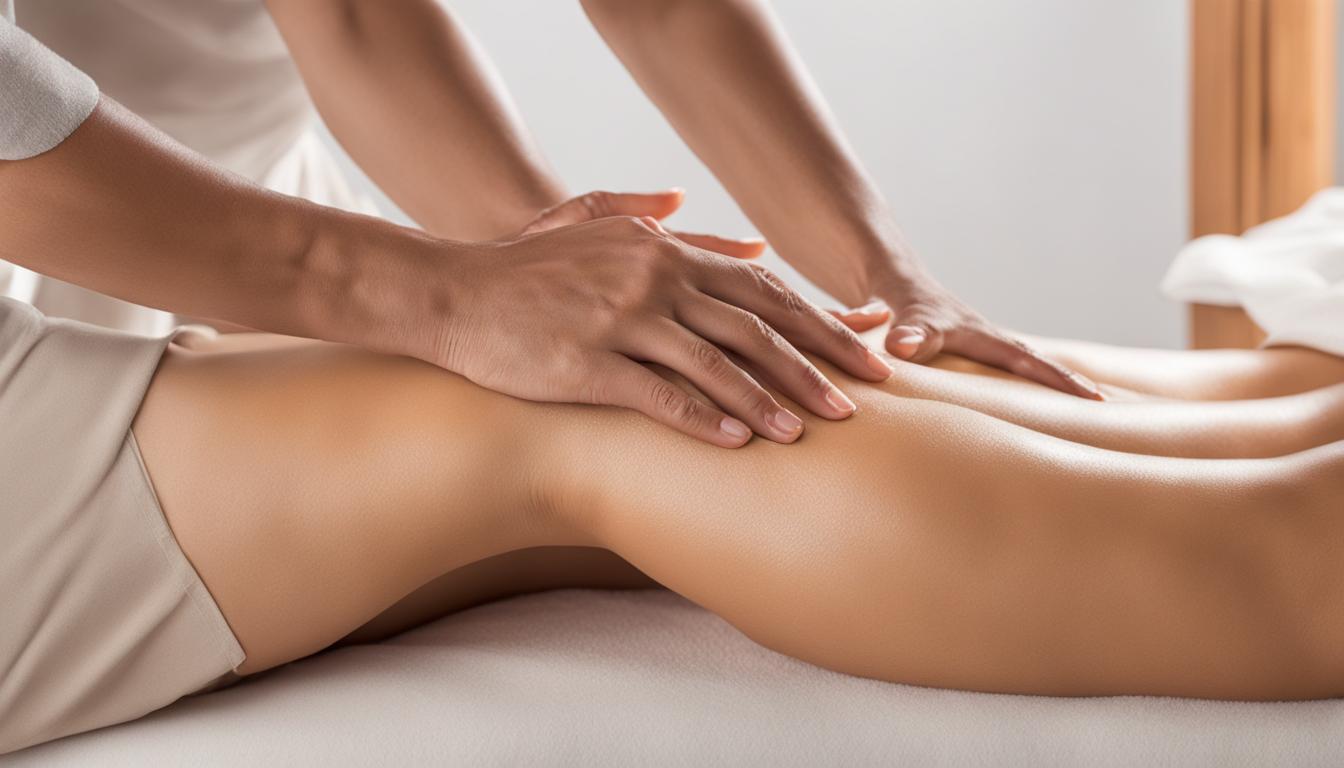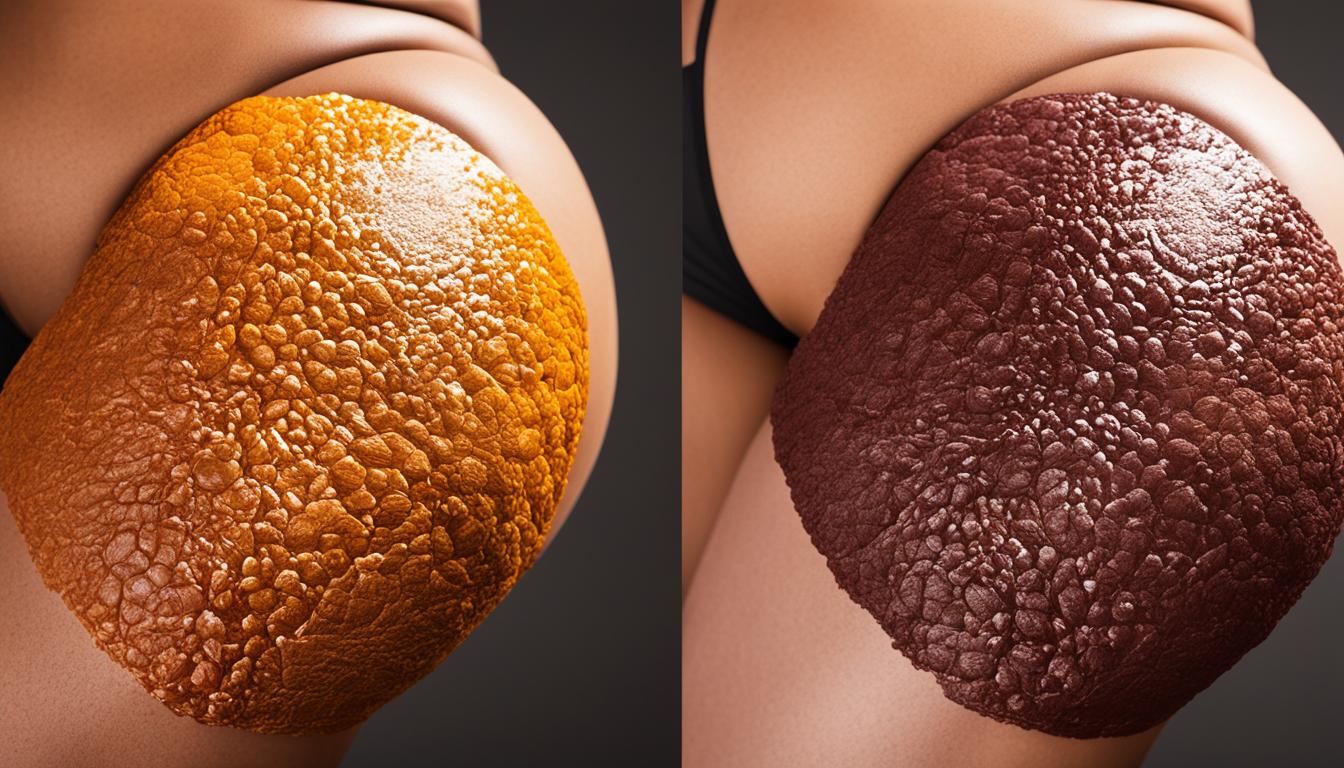Welcome to my article on cellulite! In this comprehensive guide, I will walk you through the different types of cellulite, how to identify them, and the various treatment strategies available. Whether you’re looking to reduce the appearance of cellulite or simply want to understand it better, this article is for you.
Key Takeaways:
- Cellulite is a common skin condition characterized by lumpy and dimpled skin.
- There are three main types of cellulite: soft cellulite, edematous cellulite, and hard cellulite.
- Soft cellulite is caused by a lack of muscle tone and being overweight.
- Edematous cellulite is linked to poor circulation and significant fluid retention.
- Hard cellulite is compact and often caused by a lack of physical exercise.
- Treatment strategies vary depending on the type of cellulite and may include changes in diet, exercise, and the use of specific products.
- Consulting a medical professional can help determine the best course of action for your cellulite concerns.
Soft Cellulite: Causes and Treatment
Soft cellulite is a common type of cellulite that is characterized by a gelatinous appearance on areas such as the thighs, abdomen, buttocks, and arms. It is mainly caused by a lack of muscle tone and being overweight. To reduce the appearance of soft cellulite, the following causes and treatment options should be considered:
Causes of Soft Cellulite
The main causes of soft cellulite are:
- Lack of muscle tone
- Being overweight
Treatment for Soft Cellulite
To reduce the appearance of soft cellulite, the following treatment approaches are recommended:
- Healthy Diet: Follow a healthier diet by avoiding high-fat, high-sugar, and high-salt products. This can help in reducing soft cellulite by promoting weight loss and improving overall skin health.
- Regular Exercise: Engage in regular exercise that focuses on improving muscle tone in the affected areas. Walking, running, swimming, or fitness exercises can help in toning the muscles and reduce the orange peel effect associated with soft cellulite.

By incorporating a healthy diet and regular exercise into your lifestyle, you can effectively reduce the appearance of soft cellulite and improve your overall skin texture. Remember to consult with a healthcare professional or dermatologist for personalized advice and treatment options.
Edematous Cellulite: Causes and Treatment
Edematous cellulite is a type of cellulite characterized by poor circulation and significant fluid retention. It often appears in the lower legs and can be painful when touched. Understanding the causes and implementing effective treatments is essential for managing edematous cellulite.
Causes of Edematous Cellulite
Poor circulation and fluid retention are the primary causes of edematous cellulite. When blood and lymphatic flow are compromised, excess fluids accumulate in the affected areas, leading to swelling and the characteristic appearance of cellulite. Common factors that contribute to edematous cellulite include:
- Sedentary lifestyle
- Prolonged sitting or standing
- Poor dietary choices, such as excessive salt intake
- Hormonal imbalances
- Genetic predisposition
By addressing these underlying causes, it is possible to reduce the severity of edematous cellulite.
Treatment of Edematous Cellulite
To improve circulation and reduce fluid retention associated with edematous cellulite, several treatment approaches can be beneficial:
- Regular Physical Activity: Engaging in exercise and physical activity helps stimulate blood flow and lymphatic drainage, reducing fluid buildup and swelling in the affected areas. Activities like walking, swimming, or cycling can be effective in improving circulation.
- Diuretic Foods: Certain foods have natural diuretic properties that can assist in reducing fluid retention. Including foods such as celery, leek, green tea, aubergine, red berries, onion, cabbage, pineapple, and pepper in your diet can aid in reducing edematous cellulite.
- Massage Therapy: Regular massages can help improve blood flow and lymphatic drainage, reducing fluid retention in the affected areas. Massage techniques that focus on stimulating circulation and promoting lymphatic drainage, such as lymphatic drainage massage or deep tissue massage, can be beneficial.
Implementing these treatment strategies can help alleviate the symptoms of edematous cellulite and promote healthier skin.

Hard Cellulite: Causes and Treatment
Hard cellulite is a type of cellulite that is characterized by its compact and painful nature when touched. It is often caused by a combination of factors, including a lack of physical exercise and being overweight. When we don’t exercise regularly, our muscles become weak, and this can contribute to the development of hard cellulite. Additionally, being overweight puts extra pressure on our connective tissues, causing them to harden and create the characteristic dimpled appearance of hard cellulite.
To effectively treat hard cellulite, it is important to address its underlying causes. One of the key factors is adopting a healthier diet. Consuming a balanced and nutritious diet, rich in fruits, vegetables, lean proteins, and whole grains, can help to reduce inflammation and promote healthy circulation. It is also important to stay hydrated by drinking an adequate amount of water each day.
Regular exercise is another crucial aspect of treating hard cellulite. Engaging in cardiovascular exercises, such as jogging, swimming, or cycling, can help to burn excess fat and improve muscle tone. Strength training exercises, focusing on the hips, thighs, and buttocks, can also help to tone and firm the affected areas.
In addition to a healthy diet and exercise, massage can be an effective tool in reducing the appearance of hard cellulite. Massaging the affected areas can help to stimulate blood flow, break down fat deposits, and improve lymphatic drainage. Consider using massage techniques such as kneading, rolling, or using a cellulite massager for optimal results.
| Treatment | Description |
|---|---|
| Healthy Diet | A balanced and nutritious diet can reduce inflammation and promote healthy circulation. |
| Regular Exercise | Engaging in cardiovascular and strength training exercises can burn excess fat and improve muscle tone. |
| Massage | Massaging the affected areas can stimulate blood flow, break down fat deposits, and improve lymphatic drainage. |
Indemne’s Gimme Smooth! Slimming Lotion
When it comes to reducing cellulite, Indemne’s Gimme Smooth! slimming lotion is a natural and effective solution. This lotion is carefully formulated with seven essential oils, including Eucalyptus Dives and Italian Helichrysum, which have beneficial properties for skin health.
The Gimme Smooth! lotion has been extensively tested and proven to improve skin texture while reducing the appearance of cellulite. It specifically targets the orange peel effect that commonly occurs on the legs, thighs, buttocks, and stomach.
What sets Gimme Smooth! apart is its use of natural ingredients. These ingredients work together to stimulate blood circulation, promote lymphatic drainage, and support the body’s natural skin rejuvenation process. This combination helps reduce cellulite and improve the overall appearance of the skin.
For enhanced results, the Gimme Smooth! lotion can be used in conjunction with massage cups. Massage cups, like the Bubble-In and Big Bubble-In, help stimulate blood flow, break down fat deposits, and further promote the reduction of cellulite. When used together, the lotion and massage cups create a comprehensive approach to reducing cellulite and achieving smoother, firmer skin.
Indemne’s Gimme Smooth! slimming lotion offers a natural and holistic solution to the persistent problem of cellulite. With its carefully selected ingredients and innovative usage with massage cups, Gimme Smooth! is a powerful tool in the quest for smoother, more toned skin.
| Key Features of Indemne’s Gimme Smooth! Slimming Lotion |
|---|
| Natural ingredients: The lotion is made with seven essential oils, providing natural benefits for skin health. |
| Reduces cellulite: Gimme Smooth! has been tested and proven to effectively reduce the appearance of cellulite. |
| Targets multiple areas: It specifically works on the legs, thighs, buttocks, and stomach to combat the orange peel effect. |
| Works well with massage cups: For enhanced results, the lotion can be used in combination with massage cups like the Bubble-In and Big Bubble-In. |
With Indemne’s Gimme Smooth! slimming lotion, you can confidently take steps towards reducing cellulite and achieving smoother, more toned skin. Say goodbye to the orange peel effect and embrace a more confident you!
Anatomy and Symptoms of Cellulite
Cellulite occurs when fat cells push against the skin while tough connective cords pull down, creating an uneven surface or dimpling. The appearance of cellulite is characterized by lumpy and dimpled skin, often described as having a cottage cheese or orange peel texture. It is most commonly found on the thighs, hips, buttocks, and abdomen. While cellulite is generally harmless, many people seek treatment options to improve the appearance of their skin.

| Cellulite Anatomy | Cellulite Symptoms |
|---|---|
|
|
Causes and Risk Factors of Cellulite
The exact causes of cellulite are not fully understood, but it is believed to be influenced by hormonal factors, genetics, and lifestyle. Hormonal imbalances can contribute to the development of cellulite, as well as genetic factors that determine skin structure, texture, and body type. Weight gain and a lack of muscle tone can also increase the likelihood of developing cellulite. Cellulite is more common in women and tends to run in families.
Hormonal Factors
Hormonal imbalances play a significant role in the formation of cellulite. Estrogen, insulin, and thyroid hormones are believed to impact the development of cellulite. Hormonal fluctuations that occur during puberty, pregnancy, and menopause can contribute to the appearance of cellulite. Estrogen, in particular, affects blood circulation, collagen production, and fat storage, making women more susceptible to cellulite than men.
Genetics
Genetic factors also play a crucial role in the development of cellulite. Certain genes determine skin structure, fat distribution, and the efficiency of the lymphatic system. Consequently, some individuals are predisposed to cellulite formation due to their genetic makeup. If your mother or grandmother had cellulite, there is a higher chance that you will develop it as well.
Weight and Muscle Tone
Weight gain can contribute to the appearance of cellulite as excess fat cells put pressure on the connective tissues under the skin, causing dimpling. Additionally, a lack of muscle tone can make the skin appear more uneven and prone to cellulite. Regular exercise, focusing on strength training and toning exercises, can help improve muscle tone and reduce the visibility of cellulite.
Risk Factors for Cellulite
Family HistoryIf your close relatives have cellulite, you may be more likely to develop it.
| Risk Factor | Explanation |
|---|---|
| Gender | Cellulite is more common in women due to hormonal and genetic factors. |
| Hormonal Changes | Fluctuations in hormones during puberty, pregnancy, and menopause can contribute to cellulite development. |
| Weight Gain | Excess weight can increase the visibility of cellulite as fat cells push against the connective tissues. |
| Lack of Exercise | Not engaging in regular physical activity can result in poor muscle tone, worsening the appearance of cellulite. |
While the exact causes and risk factors of cellulite may vary from person to person, understanding the influence of hormonal factors, genetics, weight, and muscle tone can help in developing effective strategies to manage and reduce the appearance of cellulite.

When to Seek Treatment for Cellulite
While cellulite is generally not a medical concern, many individuals seek treatment to improve the appearance of their skin. If you are concerned about the appearance of cellulite, it is recommended to consult with your primary care doctor or a specialist in skin diseases, such as a dermatologist or plastic surgeon.
These healthcare professionals can provide you with valuable information and options for cellulite treatment based on your specific condition and goals. They have the expertise to evaluate your skin appearance, discuss treatment options, and recommend a personalized plan to address your cellulite concerns.
By seeking treatment, you can take proactive steps towards improving the appearance of your skin and boosting your confidence. Do not hesitate to reach out to a healthcare professional who specializes in dermatology or plastic surgery to explore cellulite treatment options.
If you are unsure about which healthcare professional to consult, your primary care doctor can provide you with a referral to a reputable dermatologist or plastic surgeon who has experience in treating cellulite.
Remember, seeking cellulite treatment is a personal decision and it is important to choose a path that aligns with your goals and priorities. Consulting with a healthcare professional can help you make an informed decision and navigate the various treatment options available.
| Treatment Options | Description |
|---|---|
| Topical creams and lotions | A variety of creams and lotions are available over the counter that claim to reduce the appearance of cellulite by tightening and toning the skin. |
| Massage therapy | Massage techniques, such as lymphatic drainage or deep tissue massage, can help improve blood circulation and lymphatic drainage, potentially reducing the appearance of cellulite. |
| Laser treatments | Non-invasive laser treatments can help target and break down fat cells beneath the skin, resulting in a smoother appearance. |
| Radiofrequency treatments | Radiofrequency energy is used to heat the skin and stimulate collagen production, which can improve the overall texture and firmness of the skin. |
| Cellulite reduction exercises | Engaging in regular exercises that focus on toning the muscles in the affected areas can help reduce the appearance of cellulite. |
Remember to consult with a healthcare professional to determine the most suitable treatment options for your specific cellulite concerns.
Note: The effectiveness and results of these treatment options may vary depending on individual factors and the severity of cellulite. It is essential to consult with a healthcare professional and follow their recommendations for the best outcomes.
Diagnosis and Medical Treatments for Cellulite
Diagnosing cellulite involves a visual examination and physical evaluation of the affected areas. Healthcare professionals can determine the presence and severity of cellulite based on the appearance and texture of the skin. The diagnostic process helps in identifying the type and extent of cellulite and allows for the development of appropriate treatment strategies.
Medical treatments for cellulite offer effective solutions to improve its appearance. Two popular options are laser treatment and radiofrequency treatment.
Laser treatment involves the use of high-powered laser energy to stimulate collagen production and target the underlying fat cells and connective tissues. The laser energy helps to break down the fat deposits while tightening the skin, resulting in a smoother appearance. It is a non-invasive procedure that typically requires multiple sessions for optimal results.
Radiofrequency treatment utilizes radiofrequency energy to heat the deep layers of the skin, promoting collagen production and tightening the skin. This treatment targets cellulite by reducing the size of fat cells and improving the overall texture of the skin. Radiofrequency treatment is also non-invasive and may require several sessions for noticeable improvements.
Both laser treatment and radiofrequency treatment have shown varying levels of success in reducing the appearance of cellulite. However, it is important to note that individual results may vary, and the longevity of the effects may vary as well.
Non-Medical Treatments for Cellulite
When it comes to addressing cellulite, there are various non-medical treatments available that can help improve its appearance. These treatments focus on natural remedies, lifestyle changes, and topical solutions that can be incorporated into your daily routine.
Massage
One popular non-medical approach to reducing cellulite is through massage. Massaging the affected areas helps stimulate blood circulation and lymphatic drainage, which can have a positive impact on cellulite reduction. Some massage techniques that are commonly used for cellulite include deep tissue massage, dry brushing, and vacuum cupping therapy.
Creams and Topical Treatments
Another non-medical option for cellulite treatment is the use of creams and topical treatments. There are various creams available in the market that claim to reduce cellulite by targeting fat cells and improving skin texture. These creams often contain ingredients such as caffeine, retinol, and antioxidants that help tighten the skin and reduce the appearance of cellulite. However, it’s important to note that the effectiveness of these creams may vary from person to person.
Exercise
Regular exercise is not only beneficial for overall health but can also help in reducing the appearance of cellulite. Engaging in cardiovascular exercises, such as running, cycling, or swimming, can help burn excess fat and improve muscle tone. Strength training exercises that target the areas affected by cellulite, such as squats and lunges, can help tone and firm the muscles, making the skin appear smoother.
Lifestyle Changes
Adopting a healthy lifestyle can greatly contribute to reducing cellulite. Making dietary changes by incorporating more fruits, vegetables, and whole grains while reducing processed foods and sugar intake can help maintain a healthy weight and improve skin health. Staying hydrated by drinking an adequate amount of water can also improve skin elasticity and reduce the appearance of cellulite.
Addressing cellulite through non-medical treatments requires consistency and patience. Incorporating these treatments into your daily routine can help improve blood circulation, reduce fat cells, and enhance skin texture. However, it’s important to note that cellulite may not completely disappear, but its appearance can be significantly reduced.
Cellulite and Genetics
Genetics play a significant role in the development of cellulite. Certain hereditary factors can predispose individuals to cellulite production, making it more likely for them to develop this condition. While other factors such as race, metabolism, gender, and overall fat distribution can also contribute to cellulite, heredity is widely believed to be a key influencer.
Cellulite is more prevalent in white European ethnicities. However, it is important to note that cellulite can be seen in women from all backgrounds. This highlights the fact that genetics can impact cellulite development regardless of race or ethnicity.
Understanding the role of genetics in cellulite can provide valuable insights for individuals seeking to manage or reduce its appearance. By acknowledging the influence of hereditary factors, we can better tailor cellulite treatment strategies to address the unique genetic predispositions of each person.
Conclusion
In conclusion, there are three main types of cellulite: soft cellulite, edematous cellulite, and hard cellulite. Soft cellulite is often caused by a lack of muscle tone and being overweight. The orange peel effect associated with soft cellulite can be reduced by following a healthier diet and engaging in regular exercise.
Edematous cellulite, on the other hand, is characterized by poor circulation and significant fluid retention. To improve circulation and reduce fluid retention, incorporating regular physical activity and consuming diuretic foods such as celery, leek, and green tea can be beneficial.
Hard cellulite, compact and painful when touched, is commonly caused by a lack of physical exercise and being overweight. It can be addressed by adopting a healthier diet, engaging in regular exercise, and incorporating massage techniques to target the affected areas.
Additionally, using products like Indemne’s Gimme Smooth! slimming lotion, which is composed of natural ingredients, can help reduce the appearance of cellulite. However, it is important to note that treating cellulite requires personalized approaches as there is no one-size-fits-all solution. Individual treatment plans should be tailored to specific needs and goals to achieve optimal results.
FAQ
What are the different types of cellulite?
The different types of cellulite are soft cellulite, edematous cellulite, and hard cellulite.
What causes soft cellulite and how can it be treated?
Soft cellulite is caused by a lack of muscle tone and being overweight. It can be treated by following a healthier diet and engaging in regular exercise.
What causes edematous cellulite and how can it be treated?
Edematous cellulite is caused by poor circulation and significant fluid retention. It can be treated by improving circulation through exercise and consuming diuretic foods.
What causes hard cellulite and how can it be treated?
Hard cellulite is caused by a lack of physical exercise and being overweight. It can be treated by adopting a healthier diet, engaging in regular exercise, and using massage techniques.
What is Indemne’s Gimme Smooth! slimming lotion and how does it reduce cellulite?
Indemne’s Gimme Smooth! slimming lotion is a natural solution formulated with essential oils that improve skin texture and reduce the appearance of cellulite. It can be used with massage cups for enhanced results.
What is cellulite and what are its symptoms?
Cellulite is the dimpled and lumpy appearance of the skin, often described as having a cottage cheese or orange peel texture. It is most commonly found on the thighs, hips, buttocks, and abdomen.
What causes cellulite and who is at risk?
The exact causes of cellulite are not fully understood, but it is believed to be influenced by hormonal factors, genetics, weight, and muscle tone. Cellulite is more common in women and tends to run in families.
When should I seek cellulite treatment?
If you are concerned about the appearance of cellulite, it is recommended to consult with your primary care doctor or a specialist in skin diseases or plastic surgery. They can provide information and options for cellulite treatment based on your specific condition and goals.
How is cellulite diagnosed and what are the medical treatments available?
Cellulite is primarily diagnosed through visual examination and physical evaluation. Medical treatments for cellulite include laser and radiofrequency treatments, which target the underlying fat and connective tissues.
What are the non-medical treatments for cellulite?
Non-medical treatments for cellulite include massage, creams, exercise, and lifestyle changes. Massage can help improve blood circulation, creams, and topical treatments claim to reduce cellulite, and exercise and a healthy lifestyle can also help reduce its appearance.
Is cellulite influenced by genetics?
Yes, genetics play a role in the development of cellulite. Certain hereditary factors can predispose individuals to cellulite production, although other factors such as race, metabolism, gender, and overall fat distribution can also contribute.
What is the conclusion about the types of cellulite and their treatment options?
In conclusion, there are three main types of cellulite with different causes and treatment options. Soft cellulite can be improved with a healthier diet and exercise, edematous cellulite can be addressed through exercise and diuretic foods, and hard cellulite can be treated with a healthier diet, exercise, and massage techniques. It is important to remember that there is no one-size-fits-all solution for cellulite, and individual treatment plans should be tailored to specific needs and goals.
